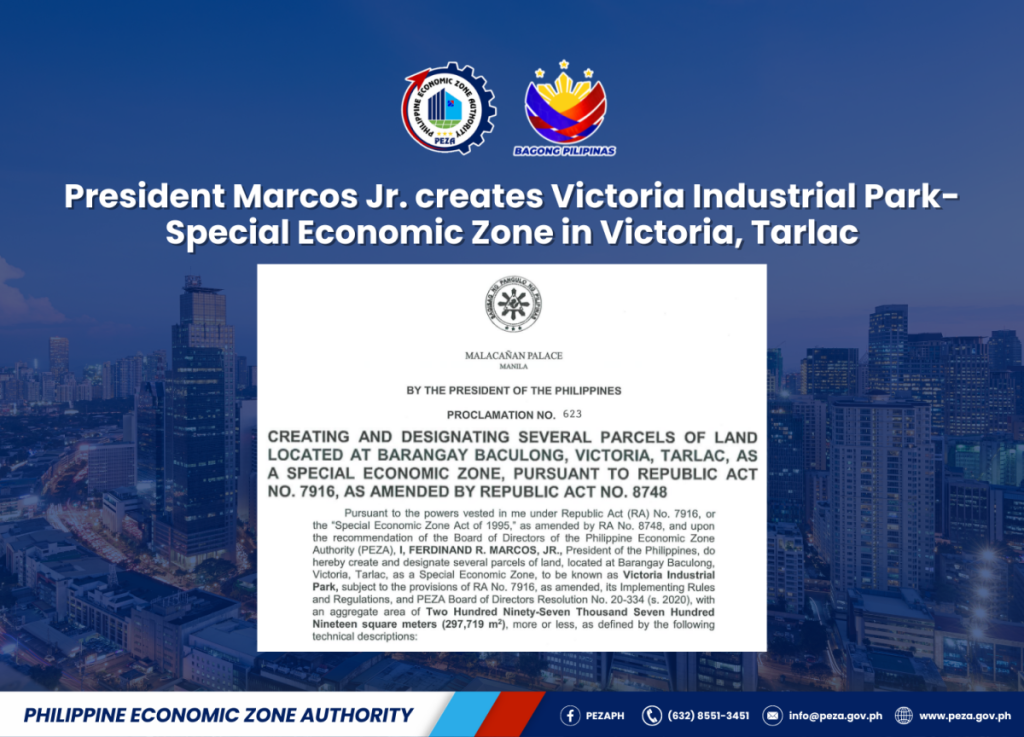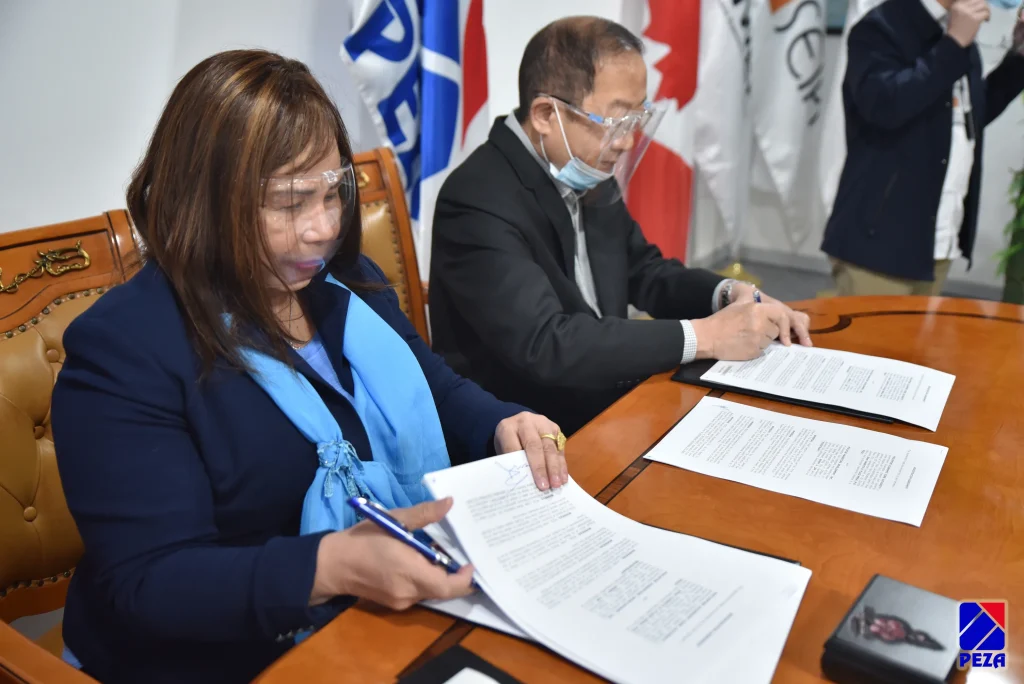PEZA eyes Tarlac and Bulacan as locations for first Pharma zones
Pasay City — The Philippine Economic Zone Authority (PEZA) cheers the proclamation of Victoria Industrial Park as President Ferdinand R. Marcos Jr. signed Proclamation No. 623 last 04 July 2024 designating a 29.77-hectare property in Barangay Baculong, Victoria, Tarlac as a special economic zone.
“This is a major milestone for our push to see the first pharmaceutical ecozone operating within this administration, and ultimately, for the country’s overall pharmaceutical industry. The establishment of the Victoria Industrial Park marks a crucial step in our broader strategy to strengthen and expand the pharmaceutical sector within the country and make medicines affordable and accessible, in line with the instruction of the President and the efforts of the Office of the Special Assistant to the President for Investment and Economic Affairs (OSAPIEA),” said PEZA Director General Tereso O. Panga.

Pharma zones
Aligned with the Philippine Development Plan 2023-2028, the establishment of pharma zones heeds the call of the President to streamline the drug application process, making it more accessible and efficient for stakeholders, encouraging more local producers to boost their R&D and manufacturing capabilities and ultimately lower drug costs for the general public.
These zones are expected to significantly boost the Philippines’ pharmaceutical industry by attracting substantial investments, advancing technological capabilities, and increasing local production and research.
“We are optimistic that this will be the start, as we intensify our initiatives on this to achieve our goal of making the Philippines a global leader in pharmaceutical manufacturing,” stated the PEZA Chief.
The Victoria Industrial Park is seen to accommodate players in the pharmaceutical industry, diversify the pharma and medical activities in the country, and encourage the creation of other pharma zones nationwide. FDA Director-General Samuel A. Zacate already expressed the agency’s intentions to put up an FDA laboratory in Tarlac.
In addition to this, PEZA-registered First Bulacan Business Park (FBBP), which was proclaimed in 2021, is also seen to host medical R&D for the manufacturing of innovative, over-the-counter and generic drug products, medical instruments/equipment, and pharma cold chain. FBBP is adjacent to the First Bulacan Industrial City (FBIC) or the Pharma City of the North, which is home to eight (8) pharma-related firms including Lloyd Laboratories, Pascual Laboratories, Lumar Pharmaceutical, Cargill Phils. and Cosmetique Asia.
As of December 2023, PEZA hosts 27 companies engaged in pharmaceutical and medical device manufacturing, including prominent names such as Terumo (Philippines) Corporation, Arkray Industry, Inc., Royale Life Pharma Inc., JMS Healthcare PHL, Inc., Philipcare Medical Manufacturing Inc., Kaneko Medical Philippine Inc., Merck Business Solutions Asia Inc., and Cargill Oil Mills Philippines, Inc. These companies have collectively generated PhP 25.525 billion in investments and created over 19,000 direct jobs.
Consequently, PEZA is home to 19 companies located in Tarlac, generating US$161.067 million in exports and creating more than 18,000 direct jobs. Meanwhile, Bulacan is home to 7 PEZA-registered enterprises, contributing US$89.973 million in exports and creating more than 11,000 direct jobs.
Partnership with FDA
In cooperation with the OSAPIEA, PEZA is in talks with the FDA to develop guidelines for registering pharmaceutical ecozones and to improve the regulatory and facilitation environment for PEZA-registered business enterprises that will engage in local manufacturing of pharmaceutical products and medical devices.
The PEZA guidelines will govern the country’s establishment and registration of pharma zones. This will provide the qualifications (including minimum infrastructure requirements) and processes for potential pharma zone developers/operators. Likewise, it will outline registrable activities that locator companies may undertake within a pharma zone for them to avail of the fiscal and non-fiscal incentives under the government’s current incentive regime.
DG Panga explained, “We are currently farming out the rough draft of the guidelines to relevant national government agencies and private experts and stakeholders, particularly pharmaceutical and medical device associations and manufacturing companies. The finalization of the guidelines will commence as soon as we consolidate and harmonize their comments/inputs on the existing version thereof.”
PEZA is also working with the FDA to revisit the decade-old MOA between the two agencies. The revised MOA will affirm the FDA’s commitment to the prompt facilitation of PEZA locators’ applications for permits, licenses, and certifications to be able to attract more pharma-related investments, particularly in the manufacturing of drugs, active pharmaceutical ingredients (APIs), and medical devices and equipment, including the conduct of clinical trials and research and development activities.
Recent developments
PEZA is engaging in industry dialogues to understand which sectors the country should attract to achieve self-sufficiency in pharmaceutical product manufacturing. These dialogues involve the Philippine Chamber of the Pharmaceutical Industry Inc. (PCPI), the Pharmaceutical and Healthcare Association of the Philippines (PHAP), and private companies such as Royal Cargo which is the first Good Distribution Practices (GDP)-certified Logistics Service Provider in the Philippines; and Royale Life Pharma, which is the first PEZA-registered pharmaceutical product manufacturer in PEZA zones.
A joint briefing was also conducted on 01 July 2024 by the Anti-Red Tape Authority (ARTA), Department of Health (DOH), FDA, and PEZA to discuss initiatives concerning medical drug and device manufacturers and provide a platform to discuss advancements in the sector.
“The proper foundations are being set and laid using a whole-of-government and industry approach to create and sustain a thriving business environment for pharmaceutical manufacturing in the Philippines. As investors come in using the Philippines as a manufacturing hub in South East Asia for dependable medicines, coupled with the application of innovative and cutting-edge solutions, I am sure that higher quality of medicines and medical supplies will be developed for the whole region. And with the Philippines as a hub using PEZA’s Pharma Ecozone model, it will increase the availability and lower the price of medicines for the Filipino people,” according to Director General Panga.
Source: “PEZA eyes Tarlac and Bulacan as locations for first Pharma zones“, PEZA, July 17, 2024, https://www.peza.gov.ph/press-releases/peza-eyes-tarlac-and-bulacan-locations-first-pharma-zones











